Child Labour in Nestle Chocolate Production: An In-depth Analysis
VerifiedAdded on 2023/06/05
|6
|1292
|448
Report
AI Summary
This report critically examines the issue of child labour within Nestle's chocolate production, focusing on the ethical and business implications of its cocoa supply chains primarily located in Ivory Coast and Ghana. The report highlights the exploitation of children in cocoa farms, where they are subjected to hazardous working conditions, long hours, and deprivation of basic rights like education and healthcare. It references the definition of child labour provided by the International Labour Organization (ILO) and details the adverse effects on children's physical and psychological development. The report also discusses how the company's code of conduct is not effectively implemented, and the systemic issues like poverty and market demands contribute to the problem. It concludes that Nestle's consumers indirectly endorse child labour when purchasing products like Kit Kat and that the company needs to take more effective measures to combat the issue.
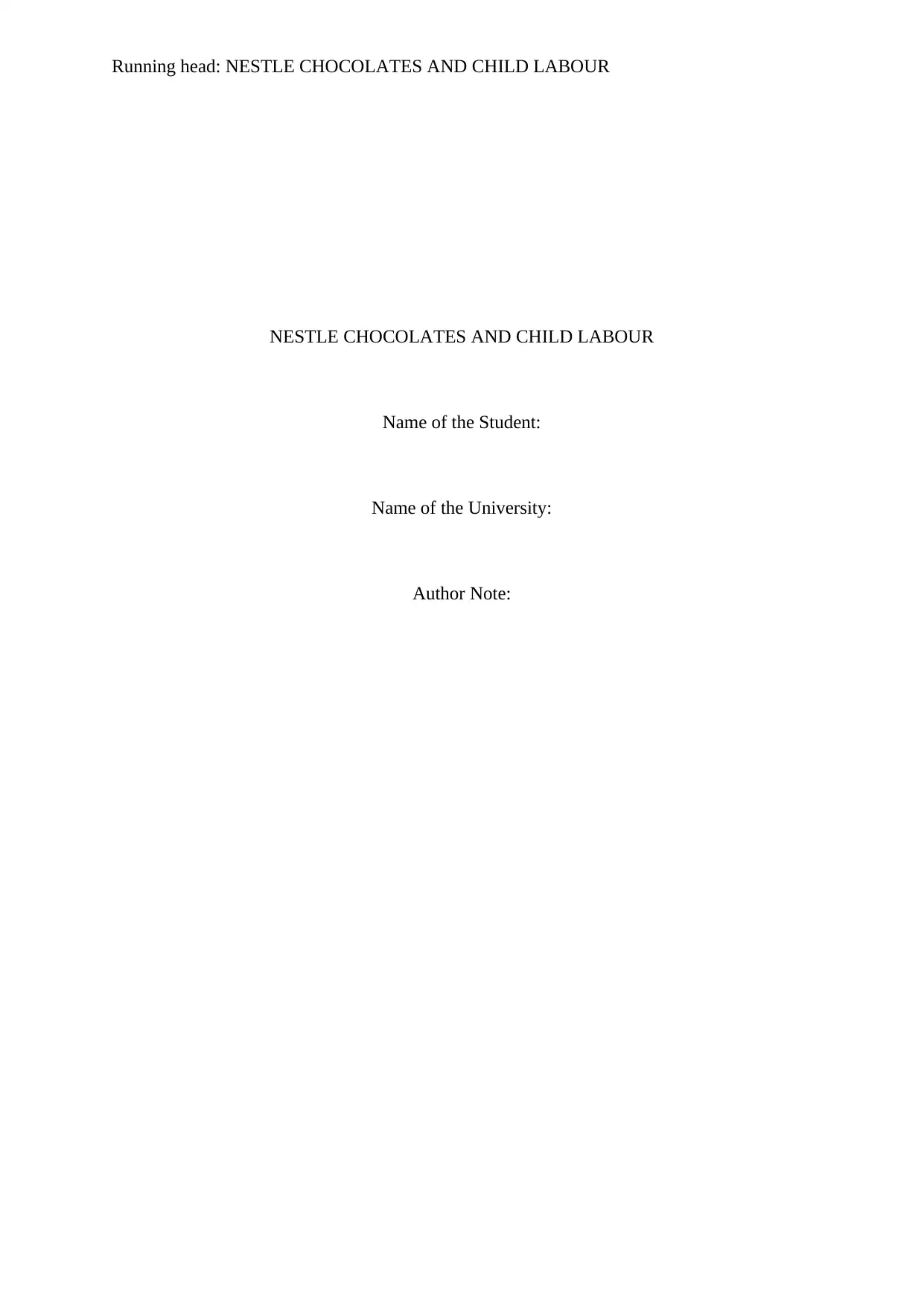
Running head: NESTLE CHOCOLATES AND CHILD LABOUR
NESTLE CHOCOLATES AND CHILD LABOUR
Name of the Student:
Name of the University:
Author Note:
NESTLE CHOCOLATES AND CHILD LABOUR
Name of the Student:
Name of the University:
Author Note:
Paraphrase This Document
Need a fresh take? Get an instant paraphrase of this document with our AI Paraphraser
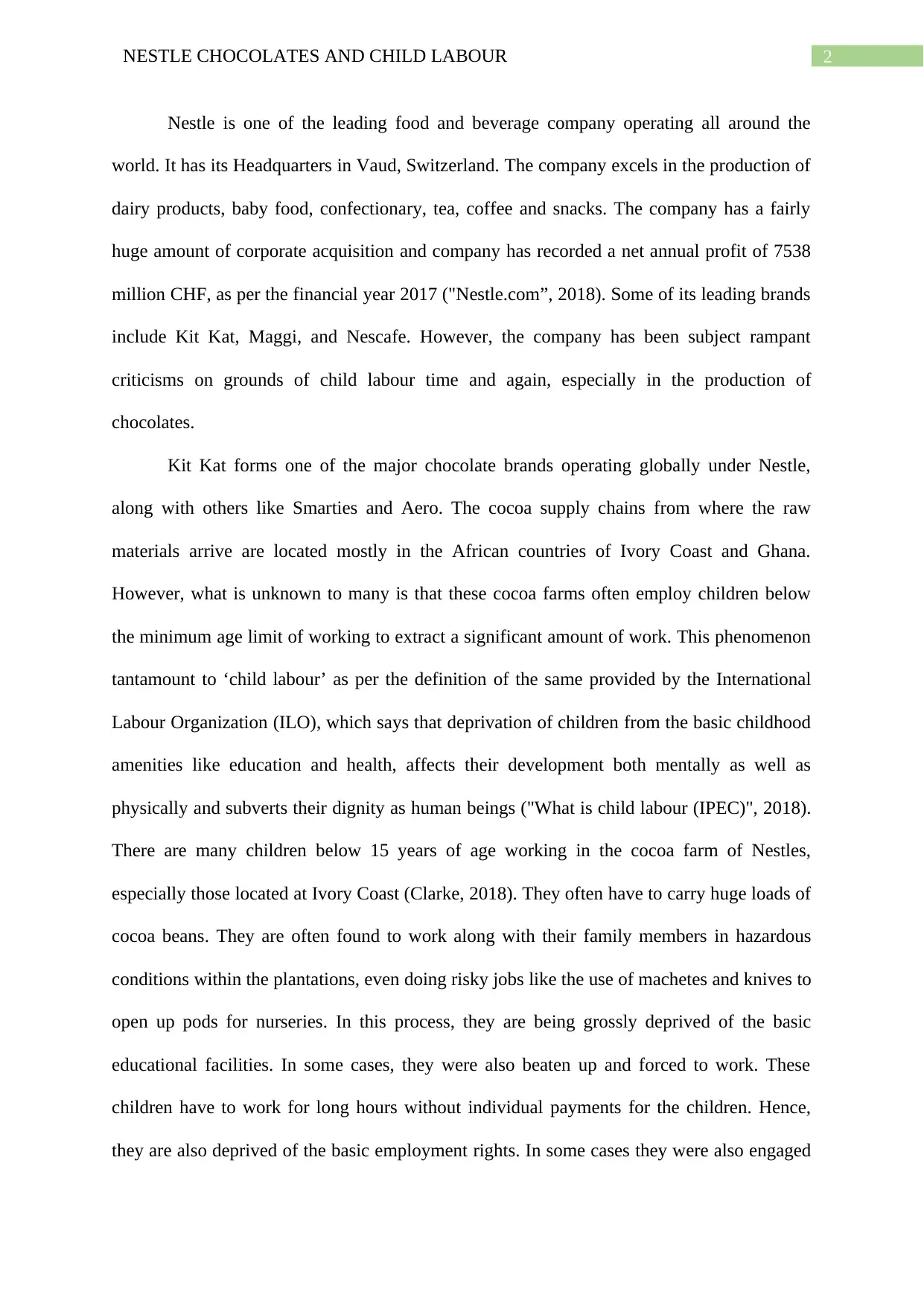
2NESTLE CHOCOLATES AND CHILD LABOUR
Nestle is one of the leading food and beverage company operating all around the
world. It has its Headquarters in Vaud, Switzerland. The company excels in the production of
dairy products, baby food, confectionary, tea, coffee and snacks. The company has a fairly
huge amount of corporate acquisition and company has recorded a net annual profit of 7538
million CHF, as per the financial year 2017 ("Nestle.com”, 2018). Some of its leading brands
include Kit Kat, Maggi, and Nescafe. However, the company has been subject rampant
criticisms on grounds of child labour time and again, especially in the production of
chocolates.
Kit Kat forms one of the major chocolate brands operating globally under Nestle,
along with others like Smarties and Aero. The cocoa supply chains from where the raw
materials arrive are located mostly in the African countries of Ivory Coast and Ghana.
However, what is unknown to many is that these cocoa farms often employ children below
the minimum age limit of working to extract a significant amount of work. This phenomenon
tantamount to ‘child labour’ as per the definition of the same provided by the International
Labour Organization (ILO), which says that deprivation of children from the basic childhood
amenities like education and health, affects their development both mentally as well as
physically and subverts their dignity as human beings ("What is child labour (IPEC)", 2018).
There are many children below 15 years of age working in the cocoa farm of Nestles,
especially those located at Ivory Coast (Clarke, 2018). They often have to carry huge loads of
cocoa beans. They are often found to work along with their family members in hazardous
conditions within the plantations, even doing risky jobs like the use of machetes and knives to
open up pods for nurseries. In this process, they are being grossly deprived of the basic
educational facilities. In some cases, they were also beaten up and forced to work. These
children have to work for long hours without individual payments for the children. Hence,
they are also deprived of the basic employment rights. In some cases they were also engaged
Nestle is one of the leading food and beverage company operating all around the
world. It has its Headquarters in Vaud, Switzerland. The company excels in the production of
dairy products, baby food, confectionary, tea, coffee and snacks. The company has a fairly
huge amount of corporate acquisition and company has recorded a net annual profit of 7538
million CHF, as per the financial year 2017 ("Nestle.com”, 2018). Some of its leading brands
include Kit Kat, Maggi, and Nescafe. However, the company has been subject rampant
criticisms on grounds of child labour time and again, especially in the production of
chocolates.
Kit Kat forms one of the major chocolate brands operating globally under Nestle,
along with others like Smarties and Aero. The cocoa supply chains from where the raw
materials arrive are located mostly in the African countries of Ivory Coast and Ghana.
However, what is unknown to many is that these cocoa farms often employ children below
the minimum age limit of working to extract a significant amount of work. This phenomenon
tantamount to ‘child labour’ as per the definition of the same provided by the International
Labour Organization (ILO), which says that deprivation of children from the basic childhood
amenities like education and health, affects their development both mentally as well as
physically and subverts their dignity as human beings ("What is child labour (IPEC)", 2018).
There are many children below 15 years of age working in the cocoa farm of Nestles,
especially those located at Ivory Coast (Clarke, 2018). They often have to carry huge loads of
cocoa beans. They are often found to work along with their family members in hazardous
conditions within the plantations, even doing risky jobs like the use of machetes and knives to
open up pods for nurseries. In this process, they are being grossly deprived of the basic
educational facilities. In some cases, they were also beaten up and forced to work. These
children have to work for long hours without individual payments for the children. Hence,
they are also deprived of the basic employment rights. In some cases they were also engaged
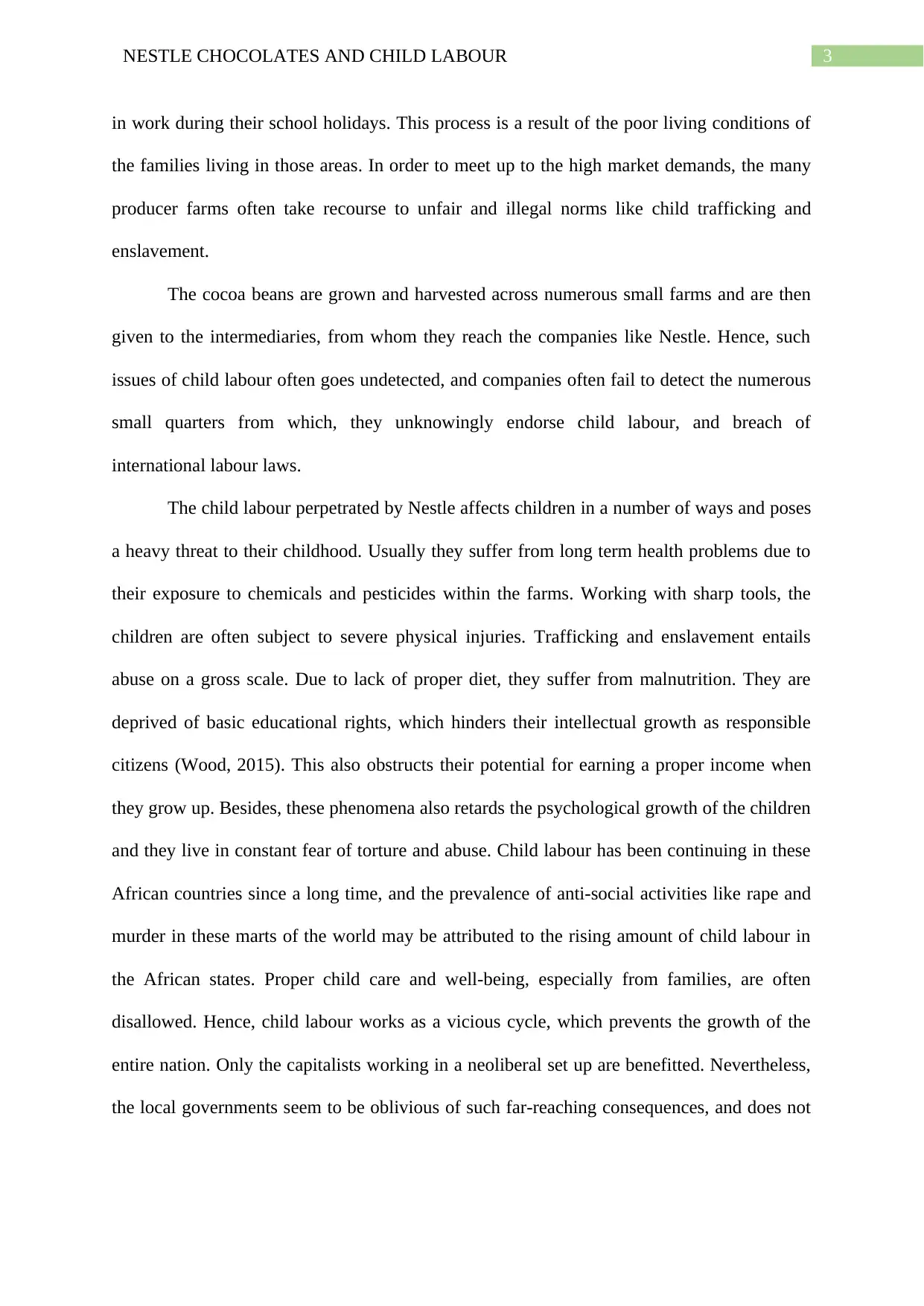
3NESTLE CHOCOLATES AND CHILD LABOUR
in work during their school holidays. This process is a result of the poor living conditions of
the families living in those areas. In order to meet up to the high market demands, the many
producer farms often take recourse to unfair and illegal norms like child trafficking and
enslavement.
The cocoa beans are grown and harvested across numerous small farms and are then
given to the intermediaries, from whom they reach the companies like Nestle. Hence, such
issues of child labour often goes undetected, and companies often fail to detect the numerous
small quarters from which, they unknowingly endorse child labour, and breach of
international labour laws.
The child labour perpetrated by Nestle affects children in a number of ways and poses
a heavy threat to their childhood. Usually they suffer from long term health problems due to
their exposure to chemicals and pesticides within the farms. Working with sharp tools, the
children are often subject to severe physical injuries. Trafficking and enslavement entails
abuse on a gross scale. Due to lack of proper diet, they suffer from malnutrition. They are
deprived of basic educational rights, which hinders their intellectual growth as responsible
citizens (Wood, 2015). This also obstructs their potential for earning a proper income when
they grow up. Besides, these phenomena also retards the psychological growth of the children
and they live in constant fear of torture and abuse. Child labour has been continuing in these
African countries since a long time, and the prevalence of anti-social activities like rape and
murder in these marts of the world may be attributed to the rising amount of child labour in
the African states. Proper child care and well-being, especially from families, are often
disallowed. Hence, child labour works as a vicious cycle, which prevents the growth of the
entire nation. Only the capitalists working in a neoliberal set up are benefitted. Nevertheless,
the local governments seem to be oblivious of such far-reaching consequences, and does not
in work during their school holidays. This process is a result of the poor living conditions of
the families living in those areas. In order to meet up to the high market demands, the many
producer farms often take recourse to unfair and illegal norms like child trafficking and
enslavement.
The cocoa beans are grown and harvested across numerous small farms and are then
given to the intermediaries, from whom they reach the companies like Nestle. Hence, such
issues of child labour often goes undetected, and companies often fail to detect the numerous
small quarters from which, they unknowingly endorse child labour, and breach of
international labour laws.
The child labour perpetrated by Nestle affects children in a number of ways and poses
a heavy threat to their childhood. Usually they suffer from long term health problems due to
their exposure to chemicals and pesticides within the farms. Working with sharp tools, the
children are often subject to severe physical injuries. Trafficking and enslavement entails
abuse on a gross scale. Due to lack of proper diet, they suffer from malnutrition. They are
deprived of basic educational rights, which hinders their intellectual growth as responsible
citizens (Wood, 2015). This also obstructs their potential for earning a proper income when
they grow up. Besides, these phenomena also retards the psychological growth of the children
and they live in constant fear of torture and abuse. Child labour has been continuing in these
African countries since a long time, and the prevalence of anti-social activities like rape and
murder in these marts of the world may be attributed to the rising amount of child labour in
the African states. Proper child care and well-being, especially from families, are often
disallowed. Hence, child labour works as a vicious cycle, which prevents the growth of the
entire nation. Only the capitalists working in a neoliberal set up are benefitted. Nevertheless,
the local governments seem to be oblivious of such far-reaching consequences, and does not
⊘ This is a preview!⊘
Do you want full access?
Subscribe today to unlock all pages.

Trusted by 1+ million students worldwide
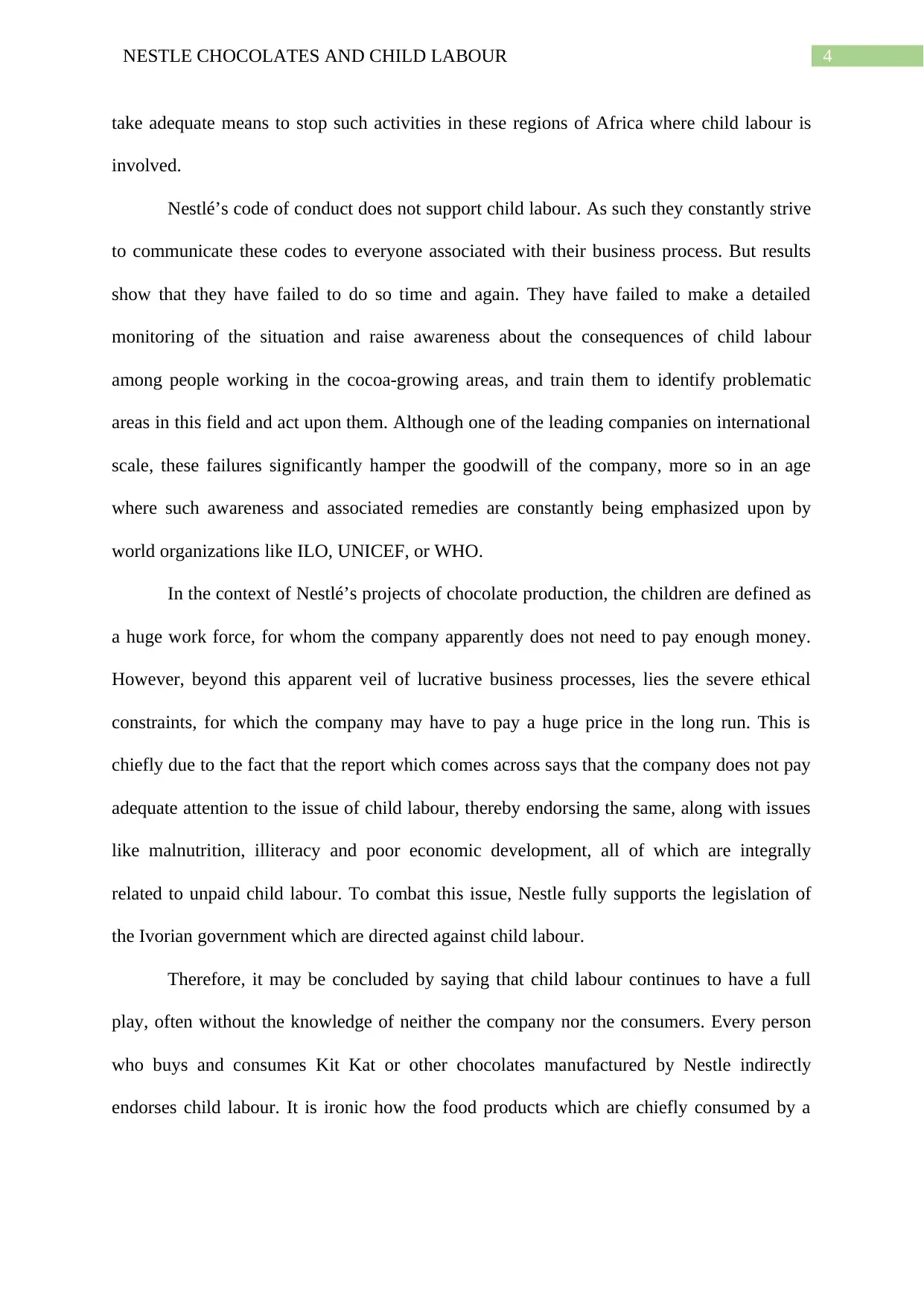
4NESTLE CHOCOLATES AND CHILD LABOUR
take adequate means to stop such activities in these regions of Africa where child labour is
involved.
Nestlé’s code of conduct does not support child labour. As such they constantly strive
to communicate these codes to everyone associated with their business process. But results
show that they have failed to do so time and again. They have failed to make a detailed
monitoring of the situation and raise awareness about the consequences of child labour
among people working in the cocoa-growing areas, and train them to identify problematic
areas in this field and act upon them. Although one of the leading companies on international
scale, these failures significantly hamper the goodwill of the company, more so in an age
where such awareness and associated remedies are constantly being emphasized upon by
world organizations like ILO, UNICEF, or WHO.
In the context of Nestlé’s projects of chocolate production, the children are defined as
a huge work force, for whom the company apparently does not need to pay enough money.
However, beyond this apparent veil of lucrative business processes, lies the severe ethical
constraints, for which the company may have to pay a huge price in the long run. This is
chiefly due to the fact that the report which comes across says that the company does not pay
adequate attention to the issue of child labour, thereby endorsing the same, along with issues
like malnutrition, illiteracy and poor economic development, all of which are integrally
related to unpaid child labour. To combat this issue, Nestle fully supports the legislation of
the Ivorian government which are directed against child labour.
Therefore, it may be concluded by saying that child labour continues to have a full
play, often without the knowledge of neither the company nor the consumers. Every person
who buys and consumes Kit Kat or other chocolates manufactured by Nestle indirectly
endorses child labour. It is ironic how the food products which are chiefly consumed by a
take adequate means to stop such activities in these regions of Africa where child labour is
involved.
Nestlé’s code of conduct does not support child labour. As such they constantly strive
to communicate these codes to everyone associated with their business process. But results
show that they have failed to do so time and again. They have failed to make a detailed
monitoring of the situation and raise awareness about the consequences of child labour
among people working in the cocoa-growing areas, and train them to identify problematic
areas in this field and act upon them. Although one of the leading companies on international
scale, these failures significantly hamper the goodwill of the company, more so in an age
where such awareness and associated remedies are constantly being emphasized upon by
world organizations like ILO, UNICEF, or WHO.
In the context of Nestlé’s projects of chocolate production, the children are defined as
a huge work force, for whom the company apparently does not need to pay enough money.
However, beyond this apparent veil of lucrative business processes, lies the severe ethical
constraints, for which the company may have to pay a huge price in the long run. This is
chiefly due to the fact that the report which comes across says that the company does not pay
adequate attention to the issue of child labour, thereby endorsing the same, along with issues
like malnutrition, illiteracy and poor economic development, all of which are integrally
related to unpaid child labour. To combat this issue, Nestle fully supports the legislation of
the Ivorian government which are directed against child labour.
Therefore, it may be concluded by saying that child labour continues to have a full
play, often without the knowledge of neither the company nor the consumers. Every person
who buys and consumes Kit Kat or other chocolates manufactured by Nestle indirectly
endorses child labour. It is ironic how the food products which are chiefly consumed by a
Paraphrase This Document
Need a fresh take? Get an instant paraphrase of this document with our AI Paraphraser
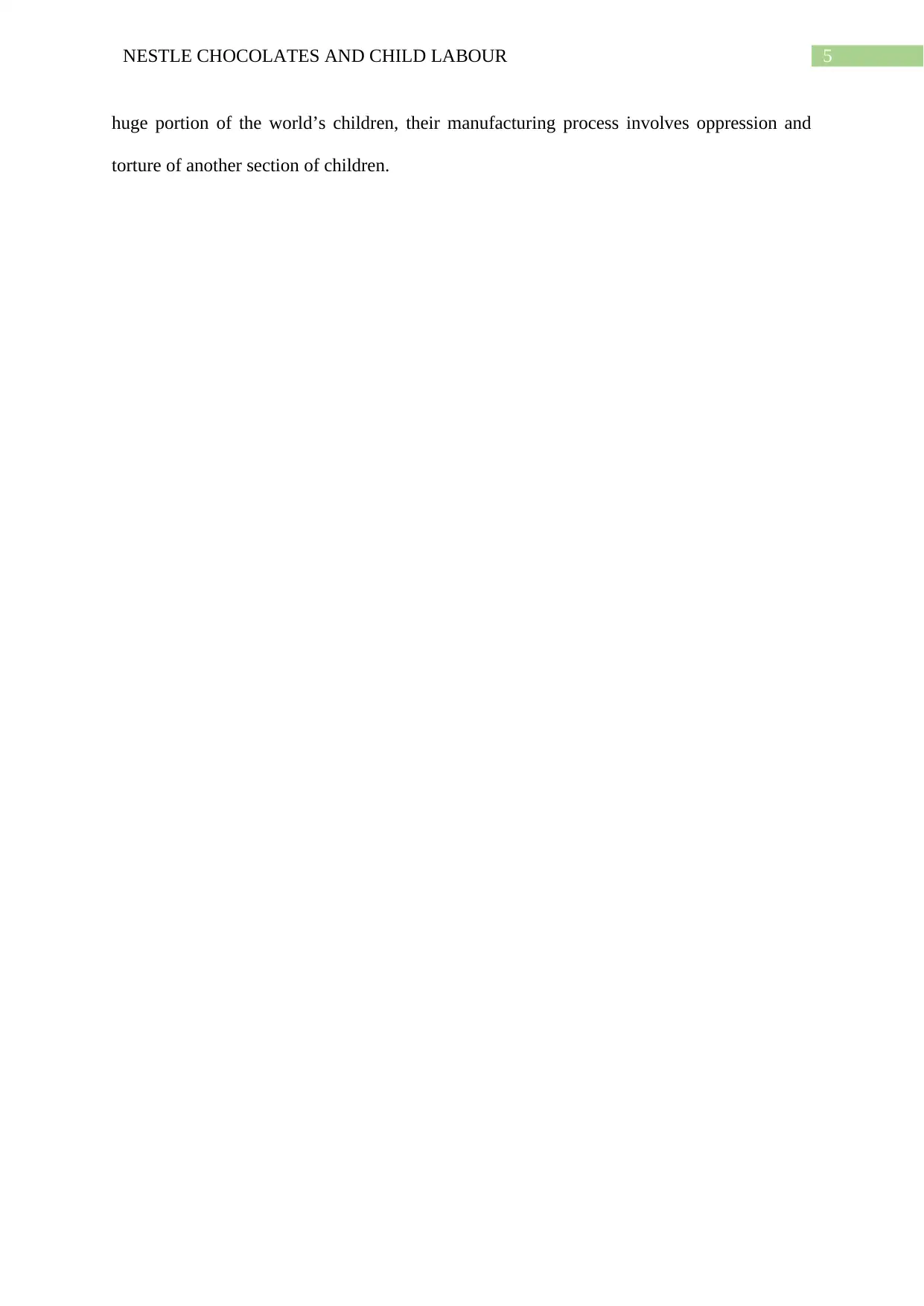
5NESTLE CHOCOLATES AND CHILD LABOUR
huge portion of the world’s children, their manufacturing process involves oppression and
torture of another section of children.
huge portion of the world’s children, their manufacturing process involves oppression and
torture of another section of children.
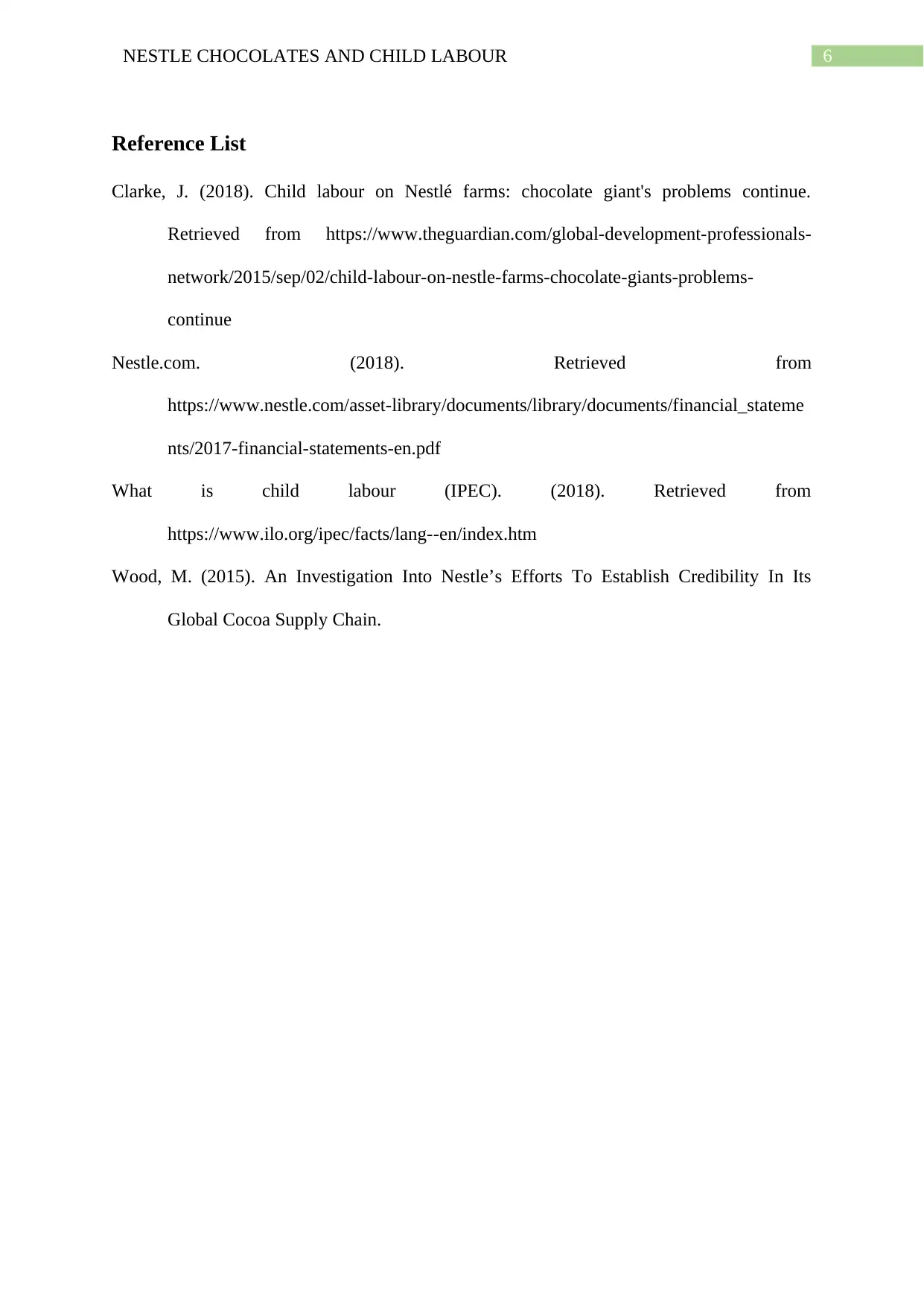
6NESTLE CHOCOLATES AND CHILD LABOUR
Reference List
Clarke, J. (2018). Child labour on Nestlé farms: chocolate giant's problems continue.
Retrieved from https://www.theguardian.com/global-development-professionals-
network/2015/sep/02/child-labour-on-nestle-farms-chocolate-giants-problems-
continue
Nestle.com. (2018). Retrieved from
https://www.nestle.com/asset-library/documents/library/documents/financial_stateme
nts/2017-financial-statements-en.pdf
What is child labour (IPEC). (2018). Retrieved from
https://www.ilo.org/ipec/facts/lang--en/index.htm
Wood, M. (2015). An Investigation Into Nestle’s Efforts To Establish Credibility In Its
Global Cocoa Supply Chain.
Reference List
Clarke, J. (2018). Child labour on Nestlé farms: chocolate giant's problems continue.
Retrieved from https://www.theguardian.com/global-development-professionals-
network/2015/sep/02/child-labour-on-nestle-farms-chocolate-giants-problems-
continue
Nestle.com. (2018). Retrieved from
https://www.nestle.com/asset-library/documents/library/documents/financial_stateme
nts/2017-financial-statements-en.pdf
What is child labour (IPEC). (2018). Retrieved from
https://www.ilo.org/ipec/facts/lang--en/index.htm
Wood, M. (2015). An Investigation Into Nestle’s Efforts To Establish Credibility In Its
Global Cocoa Supply Chain.
⊘ This is a preview!⊘
Do you want full access?
Subscribe today to unlock all pages.

Trusted by 1+ million students worldwide
1 out of 6
Related Documents
Your All-in-One AI-Powered Toolkit for Academic Success.
+13062052269
info@desklib.com
Available 24*7 on WhatsApp / Email
![[object Object]](/_next/static/media/star-bottom.7253800d.svg)
Unlock your academic potential
Copyright © 2020–2025 A2Z Services. All Rights Reserved. Developed and managed by ZUCOL.



